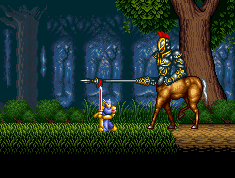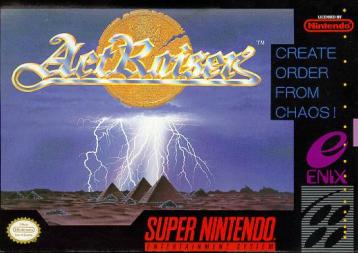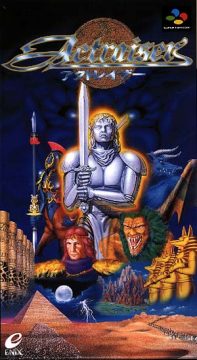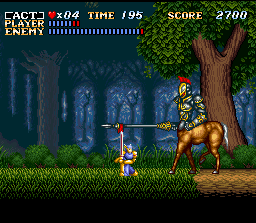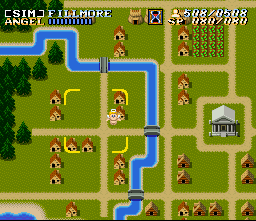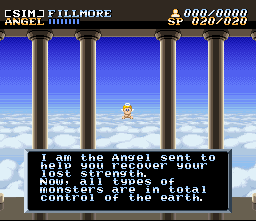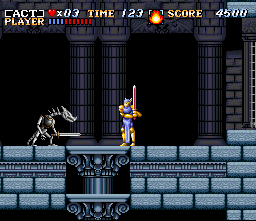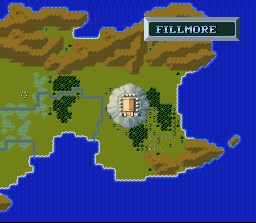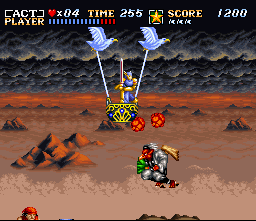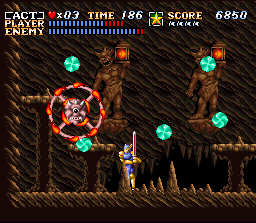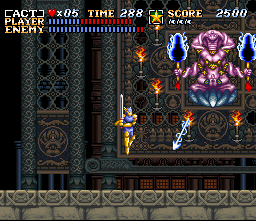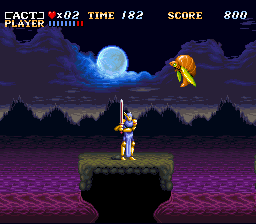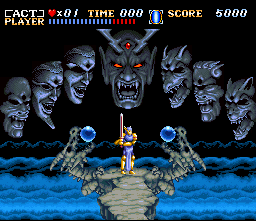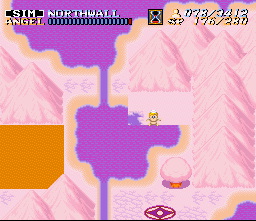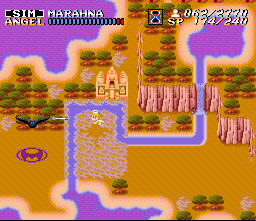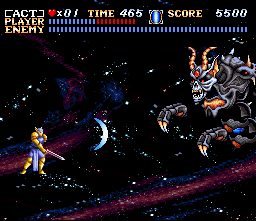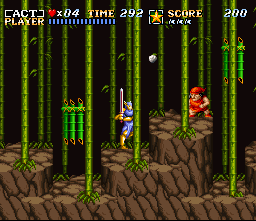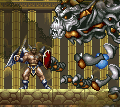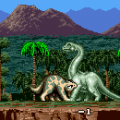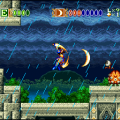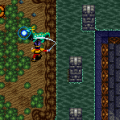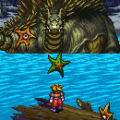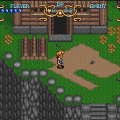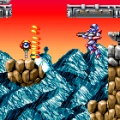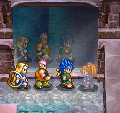- Actraiser
- Actraiser 2
As one of the many fine titles to herald the success of Nintendo’s new technical powerhouse, ActRaiser had a little something for everyone: Fast action for the brawny, strategic simulation for the brainy, incredible aesthetics for the artsy, and good challenge for the gutsy. Although every element stands well enough on their own, it’s the impressive fashion in which all aspects mesh together that make for one hell of a title. Speaking of Hell, the plot involves Satan rising up onto the real world and causing all sorts of bad shit everywhere with his six generals. You, as the one, the only, the almighty lord God, take manifest as a mighty human and singlehandedly battle Satan’s numerous forces. Now how’s that for divine wrath, eh?
Naturally, Nintendo of America’s anti-controversy stance caused them to alter the context so they wouldn’t have Bibles thrown at them by easily offended Fundamentalists who would disapprove of God being depicted in such a violent light. Thus, God was changed to “The Master” (which still sounds pretty damn cool in its own right) and Satan became “Tanzra” (which I have nothing for on the premises of etymological origin) for the American release. Despite this cover-up, it’s still pretty danged obvious that this is an adventure of biblical proportions. You start the game off in your divine palace being advised by your loyal cherub servant about the carnage going on in the mortal world. After entering your own name, he calls you by (insert moniker here) and you are given several options from your prestigious throne.
You are able to move your entire palace around above the clouds and look down on the poor unfortunate souls on the world beneath you. Oh, and your palace is nestled on top of a floating cloud. Only God is deserving of the ultimate in mobile home quality. The world upon which you look is comprised of six major lands, all of which are unique in some fashion. You control the palace above the overhead map, where you are given commands to enter levels, check your status, change the message speed, save your game’s progress with convenient battery backup, and so forth.
Now while the game’s base plot of good vs. evil is linear as can be, the story manages to become fleshed out through the individual tales of each land and how Satan’s forces have blighted their once-peaceful fields.
Fillmore: A fair land with lush forests, gentle climates, and an evil subterranean cavern from which bad dreams emanate.
Bloodpool: A marshland fittingly named after the ominous crimson lake resting in the southwest portion of the town.
Kasandora: An arid desert area responsible for beautiful music and a deadly plague ripped right from the pages of the Bible.
Aitos: A rocky town nestled in the mountains containing a volcano that threatens to come alive again thanks to heinous demons.
Marahna: A remote tropical island where unscrupulous forces of a perverse religion attempt to usurp your lofty position.
Northwall: A snow-covered town built around a massive tree, which becomes infested with pests much greater than termites.
Your job is to go around to all six of these areas and eradicate the evil festering within. How it works on paper is to go into the land of your choosing and vanquish some monsters so that the land becomes livable. You then watch over the people to see how they handle things until an even greater evil makes itself known. Once you kick the butt of said evil, the land is forevermore clear of badness and you can move on to liberating the next area from Satan’s clutches. Although you can technically roam around the world map over to any area, you can only enter Fillmore at the very beginning. You have to gain levels in order to access other areas, and how that is done is in the simulation portion which shall be soon discussed.
After entering your name in the very beginning (and your cherub servant addresses you as “Sir Michael” or whatever, which gives you an awesome sense of empowerment), it’s time to descend down to land. Oh boy, WHAT a descent it is. Every time you enter a stage in ActRaiser, you fall down from your palace, spiraling around and around (exhibiting the famous Mode 7 rotation that the SNES is known for) until you reach terra firma and the screen goes black. It’s all done to this awesome musical crescendo that really has to be seen and heard rather than described. That one single moment sums up how well the graphics and music are designed in this title. Keeping in mind that this is a first-year SNES title, the aesthetics certainly hold up well to the test of time.
The visuals make it clear that no two areas are the same, and the game runs a fine gamut of locales from forests and deserts to rocky waterfalls and unholy temples. While perhaps not quite as taxing on the Super Nintendo’s limits as Super Castlevania IV, the technical power of the machine is put to good use in the landscape. The designs of the enemies fit well into the overall mythological setup of the world, with some looking fearsome, others fierce, and yet others still just damned ugly. They are animated well for the time, but fluidity is hardly what’s most impressive about the visuals. What stands out to me is how solemn and dark everything appears, just what you would expect from a world overrun by the arch-patron of all darkness.
However, in a rare instance, the music is just as memorable as the graphics, if not even more so. Yuzo Koshiro, perhaps best known for his work on Revenge of Shinobi, various Falcom games, and the Streets of Rage trilogy, composed this game’s score. The music seems to derive some influence from the legendary John Williams, and one piece in particular sounds as if it was ripped right out of the opening of Star Wars. It all sounds fantastic and appropriate enough for each area’s mood, and the boss themes in particular stand out as dramatic pieces meant to energize and motivate you to defend yourself against the impending evil. The orchestral arrangement CD is breathtaking, although it’s quite rare and expensive to obtain a physical copy.
A fine presentation helps to augment the gameplay, which is what truly makes ActRaiser stand above most other games of its time. It’s not so much that there’s anything in the game that stands out as being super-awesome, but rather the fact that two entirely different styles of play that have almost nothing to do with each other work to demolish the notion of monotony. All six areas of the game are structured as thus: When you first come to the land, it is infested with monsters. Taking control of God who manifests himself in the statue of a great warrior, you go through a side-scrolling action sequence to slay the beasts. This makes the land inhabitable, and at this point, you switch to an overhead simulation-style of play where you control God’s cherub servant. The objective is to direct the people with the twofold purpose of bringing life to the land and learning to kick monster ass themselves. Finally, after the people become self-reliant, an incredible evil appears to shake everyone’s courage, and God drops in again to begin a second action sequence, likely more difficult than the first.
The battle scenes play out in typical action-platformer fashion akin to Castlevania or Rastan. With your holy blade, you slash at all antagonists and leap over all perils in the stage. God moves at a brisk pace and has good range with his sword, not to mention an ever-expanding lifebar. He swings the blade in a top-down arc while standing or jumping and a straighter slice while crouching. There are four magical spells found at certain points in the simulation portion of the game that can be used in the action scenes, all of which make God invincible and do big damage to all enemies and bosses. The Magical Fire toasts enemies on either side with fireballs, the Magical Stardust rains down explosive stars from above, the Magical Aura causes four flashing balls (insert obligatory bawdy remark here) to spiral out from your position, and the Magical Light summons two shining columns to wipe off all enemies. It’s arguable that the Magical Stardust, which is found fairly early in the game, does the most damage out of them all. Since magic is limited, this is not too much of a balance issue, but it makes me wonder why the Stardust is not found nearer to the game’s end.
Regardless, there is a fair deal of challenge within each level, though not so much as to completely overwhelm the action veteran. Platforming starts to get tricky around Aitos, but it’s nothing much harder than the many tricky jumps from the Mega Man series. There’s a good variety of enemies to fight, some of which can be real pests but not to the level of those damn eagles from Ninja Gaiden. The bosses look fierce and all provide good challenges, particularly Marahna’s first boss, the Rafflasher. This arboreal abomination was actually more difficult in the Japanese version, where it’s unquestionably harder than the final boss. The Japanese version is in fact harder overall with more traps and stronger enemy forces strewn about the stages. Regardless, the American version of the game is not a gentle walk, but it’s nothing vicious to the point of utter frustration.
Between both of the action sequences is a simulation segment where God’s angelic servant takes watch over the people of the newly-inhabited land. These segments play out somewhat like a simplified “god game” in the vein of Populous or Civilization. The goal in every land is to lead the people into growing strong and prosperous enough to fare on their own, and there are several commands at your disposal to accomplish this. You start out with two humans who attend the shrine and directly communicate with you to let you know about what’s going on with the town. Through means that Nintendo of America refuses to exhibit, the people grow in number. By using the Building Direction command and mapping out the next few steps of direction, people will move in the path you command and erect homes after a bit of time passes. They start out as meager mud huts but eventually develop into fine houses and large mansions. Other uses are made out of the people’s resources, such as ranches for livestock and crop fields, the latter of which are particularly instrumental in increasing population. The action of building occurs when an hourglass at the top of the screen turns over.
However, people cannot exactly develop their lives peacefully while all these nasty demons lurk around to terrorize the townsfolk. Four monster lairs are placed into every land which continue to spawn bastards from the depths of the underworld. The amount of monsters per lair is not unlimited, but the number might as well be infinite for how long it takes to drain them. In order to progress to the second action stage, you have to lead the people to these lairs so they may banish the monsters’ mark from the soil. While the people work to expel evil, your angel servant defends them from the terrors. Taking a moment to examine this little fella, I’ll overlook the obvious immaturity that can be waxed upon with the angel’s flagrant nudity and say that this guy is actually a badass. He fires off arrows to keep all monsters at bay, and not only does he never run out of ammo, but he never truly runs out of health either. If he collides with a monster, he’ll take damage, but if he runs out, he does not die. He will only be unable to attack until the hourglass turns and he regains life.
Naturally, it’s not so simple to help the people blast the demons back to hell. There are several obstructions in each game that can only be cleared through divine intervention in the form of five “miracles.” Utilizing some magic points, you are able to utilize natural elements to clear the way for the humans. They are all useful at some point or another in the game, but the most commonly-utilized one is Lightning, where 10 points create a lightning bolt that toasts everything in the area. While it’s best to clear up trees and rocks, it can also kill enemies and, unfortunately, homes if there are any nearby. 20 points go towards Rain, which restore dried crops and clear up desert terrain, a requirement to clear Kasandora. The Sun dries up marshland and melts snow for thirty points, a must to get through Bloodpool and Northwall. Wind costs a hefty 80 points, but it blows all enemies off of the map and is necessary to maintain power in Aitos. The most powerful of all is the Earthquake, which requires a massive 160 points and obliterates EVERY house in the entire area. It is, however, mandatory to shake things up in Marahna, and the destruction of houses causes the people to reconstruct them as larger buildings that are resistant to any natural disasters.
The two shrine keepers contact you on a fairly common basis, though not so much to the point of annoyance. They actually have important things to say that direct you in the right direction and even give you items every now and again. Items for use in simulation scenes increase the strength of your angel’s arrow, obliterate all demons flying on the screen, or turn corn crops into wheat to increase population. There are also several unique items that are necessary to solve problems in the six lands and progress further. Your performance in the simulation scenes directly affects action scenes, as gaining more people raises your level, which summarily increases your lifebar and makes you able to enter more areas in the game. There are also items that increase your stock of lives and magic, and the aforementioned magic spells for use in action are found in oftentimes out-of-the-way locales. It is in your best interest to try anything and everything, leaving no stone unturned or unstruck by lightning. The simulation scenes are simple for anyone to understand and reasonably fast-paced, but if you’re the hardcore type that can’t wait to get to the fight, there is a Professional mode that treats the game as a straight-on actioner, going through all thirteen stages without taking a breather. It’s unlocked after beating the game once and pressing down while “continue” is highlighted in the title screen.
ActRaiser is truly like nothing else with its ability to captivate gung-ho AND methodical gamers. Even if an action gamer shuns sims for the most part, the simulation bits are not so complex and tedious so as to entirely turn off this demographic. Conversely, the simulation gamer who prefers not to vex their mind with sidescrolling gameplay will not find the game’s action sequences too difficult to accomplish. ActRaiser meets a nice balance between the two genres to make it accessible for anyone and everyone. Wrapping it up in the motif of God vs. Satan makes this a must-play for any gamer to ever exist.
In addition to the original SNES release (which is also one of the few Square-Enix releases on the Wii Virtual Console), ActRaiser was ported to mobile phones in 2004. It’s just the action sequences, with terrible controls, no music, and completely nerfed level design that removes all of the platforming. The graphics are relatively intact, but that’s about the only positive thing you can say about it. In 2007, the real deal was made available on the Wii Virtual Console.
